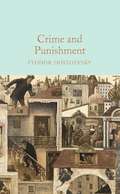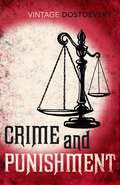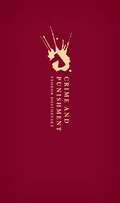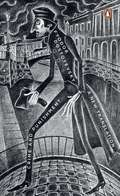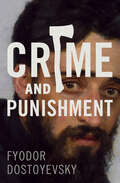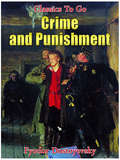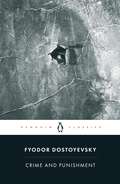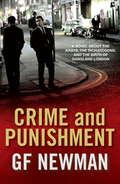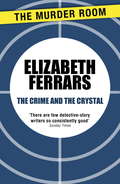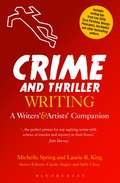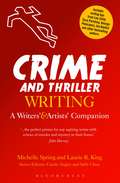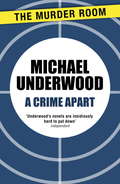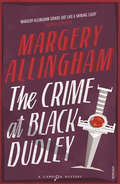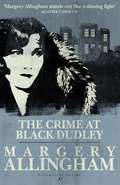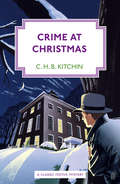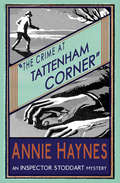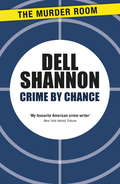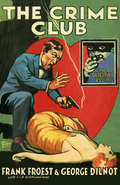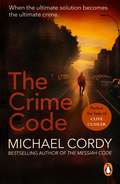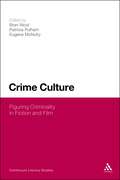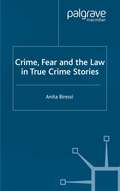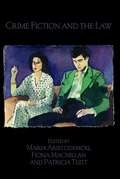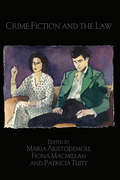- Table View
- List View
Crime and Punishment: With Selected Excerpts From The Notebooks For Crime And Punishment (Macmillan Collector's Library #96)
by Fyodor DostoevskyA towering classic of Russian literature, Fyodor Dostoevsky's Crime and Punishment is a compelling story of a brutal double murder and its aftermath. An impoverished ex-student, Rodion Raskolnikov, kills a pawnbroker and her sister, apparently for financial gain. But as he encounters friends and family, strangers and adversaries, Raskolnikov is compelled to face the true forces that have led him to murder. His struggle with himself and those around him becomes a battle of the individual against society, radicalism against tradition, and ultimately the will of man against the mysteries of divine providence. A sensation in its day, Crime and Punishment has left an indelible stamp on the world of literature. This beautiful Macmillan Collector's Library edition of Crime and Punishment is translated from the Russian by Constance Garnett, with an afterword by Oliver Francis.Designed to appeal to the booklover, the Macmillan Collector's Library is a series of beautiful gift editions of much loved classic titles. Macmillan Collector's Library are books to love and treasure.
Crime And Punishment: A Graphic Novel (Cloth Bound Pocket Ser.)
by Fyodor DostoevskyTRANSLATED BY RICHARD PEVEAR AND LARISSA VOLOKHONSKYConsumed by the idea of his own special destiny, immured in poverty and deprivation, Rashkolnikov is drawn to commit a terrible crime. In the aftermath, Rashkolnikov is dogged by madness, guilt and a calculating detective, and a feverish cat-and-mouse game unfolds. The only hope for redemption, if Rashkolnikov can but recognise it, lies in the virtuous and faithful Sonya.The Vintage Classic Russians Series: Published for the 100th anniversary of the 1917 Russian Revolution, these are must-have, beautifully designed editions of six epic masterpieces that have survived controversy, censorship and suppression to influence decades of thought and artistic expression.
Crime and Punishment: With Selected Excerpts From The Notebooks For Crime And Punishment (Oxford World's Classics)
by Fyodor Dostoevsky'One death, in exchange for thousands of lives - it's simple arithmetic!' A new translation of Dostoevsky's epic masterpiece, Crime and Punishment (1866). The impoverished student Raskolnikov decides to free himself from debt by killing an old moneylender, an act he sees as elevating himself above conventional morality. Like Napoleon he will assert his will and his crime will be justified by its elimination of 'vermin' for the sake of the greater good. But Raskolnikov is torn apart by fear, guilt, and a growing conscience under the influence of his love for Sonya. Meanwhile the police detective Porfiry is on his trail. It is a powerfully psychological novel, in which the St Petersburg setting, Dostoevsky's own circumstances, and contemporary social problems all play their part.
Crime and Punishment (Oxford World's Classics)
by Fyodor Dostoevsky'One death, in exchange for thousands of lives - it's simple arithmetic!' A new translation of Dostoevsky's epic masterpiece, Crime and Punishment (1866). The impoverished student Raskolnikov decides to free himself from debt by killing an old moneylender, an act he sees as elevating himself above conventional morality. Like Napoleon he will assert his will and his crime will be justified by its elimination of 'vermin' for the sake of the greater good. But Raskolnikov is torn apart by fear, guilt, and a growing conscience under the influence of his love for Sonya. Meanwhile the police detective Porfiry is on his trail. It is a powerfully psychological novel, in which the St Petersburg setting, Dostoevsky's own circumstances, and contemporary social problems all play their part.
Crime and Punishment: A Graphic Novel (Cloth Bound Pocket Ser.)
by Fyodor Dostoevsky Oliver Ready'A truly great translation . . . This English version really is better' - A. N. Wilson, The SpectatorTIMES LITERARY SUPPLEMENT BOOKS OF THE YEAR 2014This acclaimed new translation of Dostoyevsky's 'psychological record of a crime' gives his dark masterpiece of murder and pursuit a renewed vitality, expressing its jagged, staccato urgency and fevered atmosphere as never before. Raskolnikov, a destitute and desperate former student, wanders alone through the slums of St. Petersburg, deliriously imagining himself above society's laws. But when he commits a random murder, only suffering ensues. Embarking on a dangerous game of cat and mouse with a suspicious police investigator, Raskolnikov finds the noose of his own guilt tightening around his neck. Only Sonya, a downtrodden prostitute, can offer the chance of redemption.Fyodor Dostoevsky (1821-1881) was born in Moscow and made his name in 1846 with the novella Poor Folk. He spent several years in prison in Siberia as a result of his political activities, an experience which formed the basis of The House of the Dead. In later life, he fell in love with a much younger woman and developed a ruinous passion for roulette. His subsequent great novels include Notes from Underground, Crime and Punishment, The Idiot, Demons and The Brothers Karamazov.Oliver Ready is Research Fellow in Russian Society and Culture at St Antony's College, Oxford. He is general editor of the anthology, The Ties of Blood: Russian Literature from the 21st Century (2008), and Consultant Editor for Russia, Central and Eastern Europe at the Times Literary Supplement.
Crime and Punishment
by Fyodor DostoyevskyThe acclaimed Russian novelist’s epic morality tale of a young man’s horrifying crime and his struggle for redemption. Rodion Raskolnikov, a young man living in St. Petersburg, devises a gruesome experiment in morality. Theorizing that men of exceptional intelligence have license to kill others, he decides to test his theory with the murder of an elderly pawnbroker. Though no evidence can link him to his crime, it leaves him so deeply disturbed that he fights a constant urge to confess. Despite this, Raskolnikov goes on with his life, contending with his younger sister’s plan to marry a man of dubious character and the fate of an impoverished family for whom he feels responsible. In Fyodor Dostoyevsky’s acutely observed psychological drama, readers meet an array of brilliantly realized characters. There is Arkady Svidrigailov, the wealthy, married man infatuated with Raskolnikov’s sister; Sonya Marmeladov, the innocent young woman forced by poverty into a life of prostitution; Detective Porfiry Petrovitch, who suspects Raskolnikov but cannot prove his guilt; and Raskolnikov himself, whose horrifying offense leaves him in a long and agonizing struggle toward redemption. First published in 1866 in the Russian Messenger literary journal, Crime and Punishment met with sensational acclaim and catapulted Dostoyevsky to the pinnacle of literary fame. This ebook has been professionally proofread to ensure accuracy and readability on all devices.
Crime and Punishment: Revised Edition Of Original Version (Classics To Go #394)
by Fyodor DostoyevskyRodion Romanovich Raskolnikov, a former student, lives in a tiny garret on the top floor of a run-down apartment building in St. Petersburg. He is sickly, dressed in rags, short on money, and talks to himself, but he is also handsome, proud, and intelligent. He is contemplating committing an awful crime, but the nature of the crime is not yet clear. He goes to the apartment of an old pawnbroker, Alyona Ivanovna, to get money for a watch and to plan the crime. Afterward, he stops for a drink at a tavern, where he meets a man named Marmeladov, who, in a fit of drunkenness, has abandoned his job and proceeded on a five-day drinking binge, afraid to return home to his family. Marmeladov tells Raskolnikov about his sickly wife, Katerina Ivanovna, and his daughter, Sonya, who has been forced into prostitution to support the family. Raskolnikov walks with Marmeladov to Marmeladov’s apartment, where he meets Katerina and sees firsthand the squalid conditions in which they live.
Crime and Punishment: A Play In Three Acts (Illustrated Classics Collection)
by Fyodor Dostoyevsky'Dostoyevsky's finest masterpiece' John BayleyDostoyevsky's great novel of damnation and redemption evokes a world where the lines between innocence and corruption, good and evil, blur. It tells the story of Raskolnikov, a destitute and desperate former student, who wanders through the slums of St Petersburg and commits a random murder without remorse or regret. He imagines himself to be beyond conventional moral laws. But as he embarks on a dangerous game of cat and mouse with a police investigator, Raskolnikov is pursued by the growing voice of his conscience and finds the noose of his own guilt tightening around his neck. Translated with an Introduction and notes by DAVID McDUFF
Crime and Punishment
by Fyodor Dostoyevsky Constance Garnett[This text is listed as an example that meets Common Core Standards in English language arts in grades 11-12 at http://www.corestandards.org.]
Crime and Punishment
by G.F. NewmanIn 1951 the Festival of Britain marks a new golden age of hope and prosperity for the country. Things are certainly looking up for the criminal elite who run the East End. For Jack, a draft-dodger with aspirations to be a champion boxer, there's easy money to be made for providing a bit of muscle. Meanwhile his sister Kath must keep secret the fact that she killed their father to protect her son, Brian, from the abuse she experienced as a child. Brian is so traumatised by witnessing this event that the complex union of violence and sexuality will shape his character for life. As the years go by and disillusion sets in, successive Labour and Tory governments aren't able to stop the rot. Younger, nastier criminals like the Kray twins and the Richardson brothers begin to carve out their own criminal empires and crush all resistance. Brutalised and embittered by years of failure and imprisonment, Jack decides to make a stand. The stage is set for one big war. Crime and Punishment is the first volume in a two-part epic, and follows the characters' lives up until the accession of Thatcher. The second volume will trace the dramatic changes in criminal society that reflected the wider social upheaval of the times, right up until the present day.
The Crime and the Crystal (Andrew Basnett)
by Elizabeth FerrarsChristmas in Adelaide promises to be a pleasant vacation for Andrew Basnett, retired professor of botany and amateur sleuth. But the shadow of an unsolved murder hangs over the lives of his hosts, Tony and Jan Gardiner. The police still suspect Jan of her first husband's murder - and then a second killing takes place under the same bizarre circumstances. What can a guest do in such a case but try to clear the name of his hostess and solve the crime?'Very readable' Glasgow Herald
Crime and Thriller Writing: A Writers' & Artists' Companion (Writers’ and Artists’ Companions)
by Michelle Spring Laurie R. KingCrime and Thriller Writing: A Writers' & Artists' Companion is an essential guide to writing in these exciting genres. PART 1 explores the nature and history of the genre and helpsyou get started with ideas, planning and research. PART 2 includes tips by bestselling crime writers: Mark Billingham, S.J. Bolton, Alafair Burke, Lee Child, N. J. Cooper, Meg Gardiner, Tess Gerritsen, Sophie Hannah, Jim Kelly, Laura Lippman, Gayle Lynds, Alex McBride, Val McDermid, Dreda Say Mitchell, Sara Paretsky, Jill Paton Walsh, George Pelecanos, Ian Rankin, Peter Robinson, S. J. Rozan, Guy Saville, Yrsa Sigurðardóttir, Dana Stabenow, Andrew Taylor, Charles Todd and Laura Wilson. PART 3 contains practical advice--from shaping plots and exploring your characters to the meaning of writer's block, the power of the rewrite, and how to find an agent when your novel is complete.
Crime and Thriller Writing: A Writers' & Artists' Companion (Writers’ and Artists’ Companions)
by Michelle Spring Laurie R. KingCrime and Thriller Writing: A Writers' & Artists' Companion is an essential guide to writing in these exciting genres. PART 1 explores the nature and history of the genre and helpsyou get started with ideas, planning and research. PART 2 includes tips by bestselling crime writers: Mark Billingham, S.J. Bolton, Alafair Burke, Lee Child, N. J. Cooper, Meg Gardiner, Tess Gerritsen, Sophie Hannah, Jim Kelly, Laura Lippman, Gayle Lynds, Alex McBride, Val McDermid, Dreda Say Mitchell, Sara Paretsky, Jill Paton Walsh, George Pelecanos, Ian Rankin, Peter Robinson, S. J. Rozan, Guy Saville, Yrsa Sigurðardóttir, Dana Stabenow, Andrew Taylor, Charles Todd and Laura Wilson. PART 3 contains practical advice--from shaping plots and exploring your characters to the meaning of writer's block, the power of the rewrite, and how to find an agent when your novel is complete.
A Crime Apart (Murder Room Ser.)
by Michael UnderwoodA woman is murdered in a London suburb and the police investigation into her death is meticulously undertaken. Trying to solve the riddle is Detective Chief Inspector Chudd, newly appointed and still trying to find his feet in. When the truth finally emerges, the gallery of suspects includes the lady next door, a clock-winder, the ex-lodger, a Canadian heiress and two 'bovver boys'. This is as much a story about detection and detectives as it is about the brutal crime itself. 'As always, splendid' Oxford Mail
The Crime At Black Dudley (Albert Campion Ser.)
by Margery AllinghamTHE FIRST CAMPION MYSTERY'Margery Allingham stands out like a shining light'Agatha ChristieA suspicious death and a haunted family heirloom were not advertised when Dr George Abbershaw and a groupof London's brightest young things accepted an invitation to the mansion of Black Dudley. Skulduggery is most certainly afoot, and the party-goers soon realise that they're trapped in the secluded house. Amongst them is a stranger who promises to unravel the villainous plots behind their incarceration - but can George and his friends trust the peculiar young man who calls himself Albert Campion?
The Crime at Black Dudley (Albert Campion Ser.)
by Margery AllinghamClassic Crime from the Golden Age, the first in the Albert Campion Series. Margery Allingham is J.K. Rowling's favourite Golden Age author.George Abbershaw is set for a social weekend at Black Dudley manor, hosted by Wyatt Petrie and his elderly uncle Colonel Combe, who enjoys the company of Bright Young Things. With Meggie Oliphant in attendance, George looks forward to the chance of getting closer to the girl he's set his heart on. But when murder spoils the party, the group soon find out that not only is there a killer in their midst, but the house is under the control of notorious criminals. Trapped and at their mercy, George must find a way to thwart their diabolical plans while getting himself and Meggie out alive.Luckily for Abbershaw, among the guests is Albert Campion – a garrulous and affable party-crasher with a great knack for solving mysteries and interrogating suspects.The Crime at Black Dudley, first published in 1929, is the first novel to introduce Margery Allingham's amiable and much loved sleuth – Albert Campion.
Crime at Christmas
by C. H. Kitchin'There we were, all gathered together for a Christmas party, and plunged suddenly into gloom.'It's Christmas at Hampstead's Beresford Lodge. A group of relatives and intimate friends gather to celebrate the festive season, but their party is rudely interrupted by a violent death. It isn't long before a second body is discovered. Can the murderer be one of those in the great house? The stockbroker sleuth Malcolm Warren investigates, in this brilliantly witty mystery.'Kitchin's knowledge of the crevices of human nature lifts his crime fiction out of the category of puzzledom and into the realm of the detective novel. He was, in short, ahead of his day.' H. R. F. Keating
The Crime at Tattenham Corner: An Inspector Stoddart Mystery
by Annie HaynesThe body lay face downwards in a foot of water at the bottom of the ditch. Up to the present it has not been identified. But a card was found in the pocket with the name of –The grisly discovery was overshadowed in the public imagination by Derby Day, the most prestigious event in the English horse-racing calendar. But Peep o’ Day, the popular favourite for the Derby and owned by the murdered man, won’t run now. Under Derby rules, the death means automatic disqualification.Did someone find an ingenious if ruthless way to stop the horse from competing? Or does the solution to the demise of Sir John Burslem lie away from the racetrack? The thoughtful Inspector Stoddart starts to investigate in a crowded field of sinister suspects and puzzling diversions.The Crime at Tattenham Corner was the second of the four Inspector Stoddart mysteries, first published in 1928. This new edition features an introduction by crime fiction historian Curtis Evans.“We not only encounter thrilling surprises but are introduced to many admirably life-like characters. Miss Haynes is here at her best. Excellent as a detective tale, the book is also a charming novel.” Spectator
Crime By Chance
by Dell ShannonWith a brief note to her employer, Dorrie Mayo left her job - and another note taped to a neighbour's door claimed she was taking her baby to live with her in-laws on the other side of the U.S. A natural enough thing for a young widow with a fifteen-month-old daughter to do.Only why didn't Dorrie tell any of her friends where she was going? And why were her notes typewritten when Dorrie didn't own a typewriter? For Maddox and his colleagues of the Wilcox Street precinct, this is a conundrum that will take all their skill and resources to solve.
The Crime Club (Detective Club Crime Classics)
by Frank Froest George DilnotThe Detective Story Club’s first short story anthology is based around a London detective club and includes three newly discovered tales unpublished for 100 years, plus a story bearing an uncanny resemblance to a Conan Doyle Sherlock Holmes story but written some seven years earlier.
The Crime Code: a tense and thought-provoking thriller that you do not want to miss
by Michael CordyThe year is 2008. Violent crime has become a global epidemic, nowhere more so than in the United States. Everything from the death penalty to liberal reforms has failed. Nothing has been effective. Until now.Project Conscience promises to be the solution. It is a bold attempt by a powerful group of scientists, politicians and senior law-enforcement personnel to use gene therapy to treat male criminals and cure violent crime. But among their number are those with a more sinister agenda, who would go further and turn the dream of Project Conscience into the nightmare of Crime Zero.Luke Decker, a criminal psychologist disillusioned with the growing dependence on genetic science, is on the verge of resigning from the FBI when a death-row killer's whispered revelation threatens everything he believes in and catapults him into the heart of the conspiracy. Decker's only ally is Dr Kathy Kerr, an old flame and ideological adversary, and the geneticist behind the original Project Conscience.Together they must put aside their differences to fight against a scheme so ruthless in intent and so vast in scope that it will irrevocably change the evolution of mankind itself.Crime Zero is a terrifyingly credible thriller based on technological developments that are already with us. At its core is the story of one man's desperate fight for self-determination and free will in a world where such qualities are in danger of imminent extinction . . .
Crime Culture: Figuring Criminality in Fiction and Film
by Bran Nicol Eugene McNulty Patricia PulhamBy broadening the focus beyond classic English detective fiction, the American 'hard-boiled' crime novel and the gangster movie, Crime Culture breathes new life into staple themes of crime fiction and cinema.Leading international scholars from the fields of literary and cultural studies analyze a range of literature and film, from neglected examples of film noir and 'true crime', crime fiction by female African American writers, to reality TV, recent films such as Elephant, Collateral and The Departed, and contemporary fiction by J. G. Ballard, Kazuo Ishiguro, and Margaret Atwood. They offer groundbreaking interpretations of new elements such as the mythology of the hitman, technology and the image, and the cultural impact of 'senseless' murders and reveal why crime is a powerful way of making sense of the broader concerns shaping modern culture and society.
Crime, Fear and the Law in True Crime Stories (Crime Files)
by Anita BiressiWhy do true crime stories exert such popular fascination? What do they have to say about the fear of crime in the present moment? This book examines the historical origins and development of true crime and its evolution into distinctive contemporary forms. Embracing a range of non-fiction accounts - true crime book and magazines, law and order television, popular journalism - it traces how they harness and explore current concerns about law and order, crime and punishment and personal vulnerability.
Crime Fiction And The Law
by Maria Aristodemou Fiona Macmillan Patricia TuittThis book opens up a range of important perspectives on law and violence by considering the ways in which their relationship is formulated in literature, television and film. Employing critical legal theory to address the relationship between crime fiction, law and justice, it considers a range of topics, including: the relationship between crime fiction, legal reasoning and critique; questions surrounding the relationship between law and justice; gender issues; the legal, political and social impacts of fictional representations of crime and justice; post-colonial perspectives on crime fiction; as well as the impact of law itself on the crime fiction’s development. Introducing a new sub-field of legal and literary research, this book will be of enormous interest to scholars in critical, cultural and socio-legal studies, as well as to others in criminology, as well as in literature.
Crime Fiction and the Law (Birkbeck Law Press)
by Maria Aristodemou Fiona Macmillan Patricia TuittThis book opens up a range of important perspectives on law and violence by considering the ways in which their relationship is formulated in literature, television and film. Employing critical legal theory to address the relationship between crime fiction, law and justice, it considers a range of topics, including: the relationship between crime fiction, legal reasoning and critique; questions surrounding the relationship between law and justice; gender issues; the legal, political and social impacts of fictional representations of crime and justice; post-colonial perspectives on crime fiction; as well as the impact of law itself on the crime fiction’s development. Introducing a new sub-field of legal and literary research, this book will be of enormous interest to scholars in critical, cultural and socio-legal studies, as well as to others in criminology, as well as in literature.
